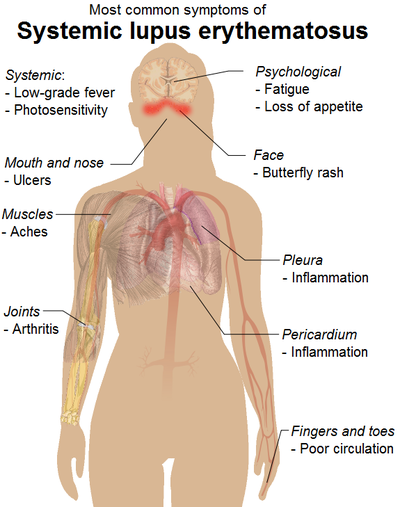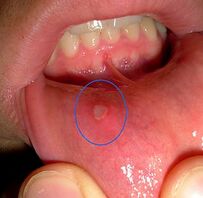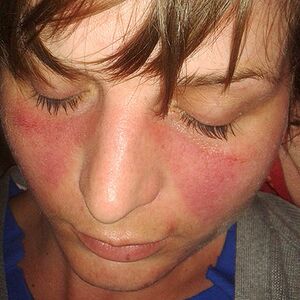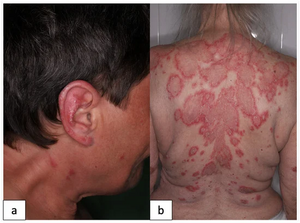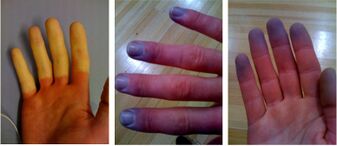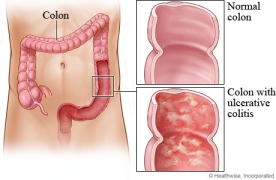Systemic Lupus Erythematosus: Difference between revisions
Kim Jackson (talk | contribs) mNo edit summary |
(corrected references, added paragraph to paatholog, replaced images with free one) |
||
| Line 5: | Line 5: | ||
== Definition/Description == | == Definition/Description == | ||
[[File:SLE.png|right|frameless|507x507px]] | [[File:SLE.png|right|frameless|507x507px]] | ||
Systemic lupus erythematosus (SLE) is an | Systemic lupus erythematosus (SLE) is a chronic [[Types of Rheumatic Disease|autoimmune disease]] characterized by an inflammation of connective tissue disease with variable manifestations. | ||
* SLE may affect many organ systems with immune complexes and a large array of autoantibodies, particularly antinuclear antibodies (ANAs). | * SLE may affect many organ systems with immune complexes and a large array of autoantibodies, particularly antinuclear antibodies (ANAs). | ||
* Although abnormalities in almost every aspect of the immune system have been found, the key defect is thought to result from a loss of self-tolerance to autoantigens.<ref name=":2"> | * Although abnormalities in almost every aspect of the immune system have been found, the key defect is thought to result from a loss of self-tolerance to autoantigens.<ref name=":2">Ameer MA, Chaudhry H, Mushtaq J, Khan OS, Babar M, Hashim T, Zeb S, Tariq MA, Patlolla SR, Ali J, Hashim SN. [https://www.ncbi.nlm.nih.gov/pmc/articles/PMC9662848/ An overview of systemic lupus erythematosus (SLE) pathogenesis, classification, and management.] Cureus. 2022 Oct 15;14(10).</ref> | ||
* It is a disease characterized by relapses, flares, and remissions. | * It is a disease characterized by relapses, flares, and remissions. | ||
* Common manifestations, in addition to the malar rash, include cutaneous photosensitivity, nephropathy, serositis, and [[Arthritis|polyarthritis.]] | * Common manifestations, in addition to the malar rash, include cutaneous photosensitivity, nephropathy, serositis, and [[Arthritis|polyarthritis.]] | ||
* The overall outcome of the disease is highly variable with extremes ranging from permanent remission to death<ref | * The overall outcome of the disease is highly variable with extremes ranging from permanent remission to death<ref name=":2" />. | ||
== Epidemiology == | == Epidemiology == | ||
* There is a strong female predilection in adults, with women affected 9-13 times more than males. In children, this ratio is reversed, and males are affected two to three times more often. | * There is a strong female predilection in adults, with women affected 9-13 times more than males. In children, this ratio is reversed, and males are affected two to three times more often. | ||
* Can affect any age group - the peak age at onset around the 2nd to 4th decades, with 65% of patients presenting between the ages of 16 and 65 years (i.e. during childbearing years). | * Can affect any age group - the peak age at onset around the 2nd to 4th decades, with 65% of patients presenting between the ages of 16 and 65 years (i.e. during childbearing years). | ||
* Disease is more common in childbearing age in women however it has been well reported in the pediatric and [[Older People - An Introduction|elderly]] population. SLE is more severe in children while in the elderly, it tends to be more insidious onset and has more pulmonary involvement and serositis and less Raynaud's, malar rash, nephritis, and neuropsychiatric complications<ref> | * Disease is more common in childbearing age in women however it has been well reported in the pediatric and [[Older People - An Introduction|elderly]] population. SLE is more severe in children while in the elderly, it tends to be more insidious onset and has more pulmonary involvement and serositis and less Raynaud's, malar rash, nephritis, and neuropsychiatric complications<ref>Tsai HL, Chang JW, Lu JH, Liu CS. Epidemiology and risk factors associated with avascular necrosis in patients with autoimmune diseases: a nationwide study. Korean J Intern Med. 2022 Jul;37(4):864-876. </ref> | ||
* Studies have indicated that although rare, lupus in men tends to be more severe. | * Studies have indicated that although rare, lupus in men tends to be more severe. | ||
* Prevalence varies according to ethnicity with ratios as high as 1:500 to 1:1000 in Afro-Caribbeans and indigenous Australians, down to 1:2000 in Caucasians.<ref name=":2" /> | * Prevalence varies according to ethnicity with ratios as high as 1:500 to 1:1000 in Afro-Caribbeans and indigenous Australians, down to 1:2000 in Caucasians.<ref name=":2" /> | ||
| Line 28: | Line 28: | ||
== Pathological Process == | == Pathological Process == | ||
[[File:Oral Ulcers.jpg|alt=This could be how an oral ulceration looks in a person with SLE. This image was included courtesy of http://www.thedailystar.net/photo.|border|right|203x203px]] | |||
SLE can affect multiple components of the immune system, including the | SLE can affect multiple components of the immune system, including the | ||
* Complement system (i.e. a part of the immune system that enhances the ability of antibodies and phagocytic cells to clear microbes and damaged cells from an organism, promote inflammation, and attack the pathogen's cell membrane), | |||
* Complement system ( | * T-suppressor cells: in SLE T cells are key players in causing inflammation and autoimmunity. They release pro-inflammatory cytokines, stimulate B cells to produce harmful autoantibodies, and maintain the disease through autoreactive memory T cells. However, SLE patients exhibit abnormal T cell ratios and functions. T follicular helper (Tfh) cells, essential for immune responses, expand excessively in SLE due to interactions with antigen-presenting cells and TLR7 activation. This leads to heightened antibody production and immune tolerance breakdown. Conversely, regulatory T (Treg) <ref>Giang S, La Cava A. Regulatory T cells in SLE: biology and use in treatment. Current rheumatology reports. 2016 Nov;18:1-9.</ref>cells, responsible for immune control, are impaired in SLE, partly due to reduced IL-2 levels caused by low activator protein 1 (AP-1) expression. IL-2 also helps restrain the pro-inflammatory cytokine IL-17, elevated in SLE, contributing to tissue damage. Overall, T cell dysregulation is a central feature in SLE pathogenesis<ref>Clinical relevance of T follicular helper cells in systemic lupus erythematosus. Nakayamada S, Tanaka Y. Expert Rev Clin Immunol. 2021;17:1143–1150</ref>. | ||
* T-suppressor cells | |||
* Cytokine production. | * Cytokine production. | ||
Emerging evidence has demonstrated a key player in the generation of autoantigens in SLE is the increase in generation (i.e. increased apoptosis) and/or decrease in clearance of apoptotic cell materials (i.e., decreased phagocytosis). | Emerging evidence has demonstrated a key player in the generation of autoantigens in SLE is the increase in generation (i.e. increased apoptosis) and/or decrease in clearance of apoptotic cell materials (i.e., decreased phagocytosis). | ||
| Line 37: | Line 37: | ||
Results in generation of autoantibodies, which may circulate for many years prior to the development of overt clinical SLE. The disease tends to have a relapsing and remitting course.<ref name=":2" /> | Results in generation of autoantibodies, which may circulate for many years prior to the development of overt clinical SLE. The disease tends to have a relapsing and remitting course.<ref name=":2" /> | ||
SLE has a myriad of clinical features: | == Clinical Presentation == | ||
'''SLE has a myriad of clinical features:''' | |||
* CNS manifestations of systemic lupus erythematosus (CNS lupus): neuropsychiatric events can occur in ~45% (range 14-75%) of cases | * CNS manifestations of systemic lupus erythematosus (CNS lupus): neuropsychiatric events can occur in ~45% (range 14-75%) of cases | ||
* | * Gastrointestinal manifestations of systemic lupus erythematosus: there may be GI involvement in ~20% of cases (Ascites, peritonitis, oral ulcers, esophageal dysmotility, and protein-losing enteropathy) | ||
* | * Musculoskeletal manifestations of systemic lupus erythematosus (Jaccoud's arthropathy, arthralgia, [[arthritis]], synovitis, tenosynovitis, and myositis) | ||
* Renal manifestations of systemic lupus erythematosus ( Proteinuria, hematuria, and glomerulonephritis). | |||
* Cardiovascular manifestation (Libman-sacks-endocarditis, pericarditis, myocarditis). | |||
* [[Thoracic Anatomy|Thoracic]] manifestations of systemic lupus erythematosus (Pleuritis, pulmonary arterial HTN, interstitial lung disease, pleural effusion).<ref name=":2" /><ref name="Goodman et al">Goodman CC, Fuller KS. Pathology: Implications for the Physical Therapist. 3rd edition. St. Louis, Missouri: Saunders Elsevier, 2009.</ref> | |||
SLE can affect many organs of the body, but it rarely affects them all. The following list includes common signs and symptoms of SLE in order of the most to least prevalent. | |||
[[File:SLE rash.jpg|alt=This image illustrates the typical distribution pattern of the butterfly (malar) rash that can be a characteristic of SLE. This picture was included courtesy of: http://images.google.com.|thumb|SLE rash]] | |||
All of the below symptoms might not be present at the initial diagnosis of SLE, but as the disease progresses more of a person’s organ systems become involved.<ref name=":0">Cojocaru M, Cojocaru IM, Silosi I, Vrabie CD. [https://www.ncbi.nlm.nih.gov/pmc/articles/PMC3391953/#:~:text=Constitutional%20manifestations&text=The%20general%20symptoms%20include%3A%20fever,or%20recurrent%20active%20SLE%20flares. Manifestations of systemic lupus erythematosus]. Maedica. 2011 Oct;6(4):330.</ref> | |||
[[File:Discoid ras with SLE.webp|thumb|Discoid rash ears, and upper back]] | |||
The most common symptoms associated with SLE are: | The most common symptoms associated with SLE are: | ||
*Constitutional symptoms (fever, malaise, fatigue, weight loss): most commonly fatigue and a low-grade fever | *Constitutional symptoms (fever, malaise, fatigue, weight loss): most commonly fatigue and a low-grade fever. | ||
*Achy joints (arthralgia) | *Achy joints (arthralgia) | ||
*Arthritis (inflamed joints) | *Arthritis (inflamed joints) | ||
* | *Skin rashes; top facial rash, and bottom discoid rash | ||
*Pulmonary involvement (symptoms include: chest pain, difficulty breathing, and cough) | *Pulmonary involvement (symptoms include: chest pain, difficulty breathing, and cough) | ||
*Anemia | *Anemia | ||
| Line 59: | Line 60: | ||
*Sensitivity to the sun or light (photosensitivity) | *Sensitivity to the sun or light (photosensitivity) | ||
*Hair loss | *Hair loss | ||
*Raynaud’s phenomenon | *[[Raynaud's Phenomenon|Raynaud’s phenomenon]] | ||
*CNS involvement (seizures, headaches, peripheral neuropathy, cranial neuropathy, cerebrovascular accidents, | *CNS involvement (seizures, [[Headaches and Dizziness|headaches]], peripheral neuropathy, cranial neuropathy, cerebrovascular accidents, neurocognitive disorder, psychosis) | ||
*Mouth, nose, or vaginal | *Mouth, nose, or vaginal ulcers<ref name="Goodman et al" /> | ||
*The most common signs and symptoms of SLE in children | *The most common signs and symptoms of SLE in children and adolescents are: fever, fatigue, weight loss, arthritis, rash, and renal disease.<ref name="Tucker et al">Tucker LB. Making the diagnosis of systemic lupus erythematosus in children and adolescents. Lupus. 2007 Aug;16(8):546-9.</ref> | ||
=== Systemic Involvement === | === Systemic Involvement === | ||
There are many visceral systems can be affected from SLE, but the extent of the body's involvement differs from person to person. | There are many visceral systems can be affected from SLE, but the extent of the body's involvement differs from person to person. Some people diagnosed with SLE have only few visceral systems involved, while others have numerous systems that have been affected by the disease. | ||
==== Musculoskeletal System ==== | ==== Musculoskeletal System ==== | ||
| Line 87: | Line 88: | ||
==== Central Nervous System ==== | ==== Central Nervous System ==== | ||
[[File:Raynaud phenomenon.jpg|alt=This illustration was included courtesy of http://www.medicinenet.com.|thumb|337x337px|Raynaud phenomenon]] | |||
*Emotional instability | |||
*Psychosis | |||
*Seizures | |||
*[[Stroke|Cerebrovascular accidents ]] | |||
*Cranial neuropathy | *Cranial neuropathy | ||
*Peripheral [[Neuropathies|neuropathy]] | *Peripheral [[Neuropathies|neuropathy]] | ||
| Line 96: | Line 98: | ||
==== Renal System ==== | ==== Renal System ==== | ||
*Glomerulonephritis -inflammatory disease of the kidneys | *Glomerulonephritis -inflammatory disease of the kidneys | ||
*Hematuria | *Hematuria | ||
| Line 103: | Line 105: | ||
==== Cutaneous System ==== | ==== Cutaneous System ==== | ||
*Calcinosis | *Calcinosis | ||
*Cutaneous vasculitis | *Cutaneous vasculitis | ||
*Hair loss | *Hair loss | ||
*Raynaud's phenomenon | *Raynaud's phenomenon | ||
*Mucosal ulcers | *Mucosal ulcers | ||
| Line 111: | Line 113: | ||
==== Blood Disorders ==== | ==== Blood Disorders ==== | ||
*Anemia | *[[Anaemia|Anemia]] | ||
*Thrombocytopenia | *Thrombocytopenia | ||
*Leukopenia | *Leukopenia | ||
| Line 129: | Line 131: | ||
=== Associated Co-morbidities === | === Associated Co-morbidities === | ||
Include:[[Fibromyalgia]].<ref name="Goodman cc et al">Goodman CC | Include: | ||
* [[Fibromyalgia]].<ref name="Goodman cc et al">Goodman CC, Snyder TE. Differential diagnosis for physical therapists screening for referral, Saunders Elsevier, St. Louis, MO. 2007:274-364.</ref> | |||
* Atherosclerosis<ref name="Becker-Merok et al">Becker-Merok A, Nossent JC. Prevalence, predictors and outcome of vascular damage in systemic lupus erythematosus. Lupus. 2009 May;18(6):508-15.</ref> <ref name="Bertsias et al">Bertsias G, Gordon C, Boumpas DT. Clinical trials in systemic lupus erythematosus (SLE): lessons from the past as we proceed to the future–the EULAR recommendations for the management of SLE and the use of end-points in clinical trials. Lupus. 2008 May;17(5):437-42.</ref> | |||
* Lupus Nephritis- leads to End Stage Renal Disease (ESRD) | |||
* Anemia<ref name="Windgard">Wingard R. Increased risk of anemia in dialysis patients with comorbid diseases. Nephrology Nursing Journal. 2004 Mar 1;31(2):211.</ref> | |||
* Some types of [[Oncological Disorders|cancers]] (especially non-Hodgkin's lymphoma and lung cancer) <ref name="Bertsias et al" /><ref name="Mayo Clinic">Medical Foundation for Medical Education and Research. Mayo Clinic: Lupus Page. www.mayoclinic.com. Updated October 20, 2009. Accessed February 17, 2010.</ref> <ref name="Bernatsky - SLE">Bernatsky S, Boivin JF, Joseph L, Rajan R, Zoma A, Manzi S, Ginzler E, Urowitz M, Gladman D, Fortin PR, Petri M. An international cohort study of cancer in systemic lupus erythematosus. Arthritis & Rheumatism. 2005 May;52(5):1481-90.</ref> | |||
* Infections | |||
* Hypertension | |||
* Dyslipidemia | |||
* [[Diabetes Mellitus Type 2|Diabetes Mellitus]] | |||
* [[Osteoporosis]] | |||
* [[Avascular Necrosis]] <ref name="Bertsias et al" /> | |||
== Diagnosis == | == Diagnosis == | ||
| Line 188: | Line 202: | ||
*Education: It is essential for patients with skin lesions to have appropriate education on the best way to care for their skin and to ensure they do not experience additional skin breakdown. | *Education: It is essential for patients with skin lesions to have appropriate education on the best way to care for their skin and to ensure they do not experience additional skin breakdown. | ||
*Aerobic [[Therapeutic Exercise|Exercise]]: One of the most common impairments that patients with SLE experience is generalized fatigue that can limit their activities throughout the day.<ref name="Goodman et al" /> Graded aerobic exercise programs are more successful than relaxation techniques in decreasing the fatigue levels of patients with SLE. Aerobic activity causes many with SLE to feel much better. The aerobic exercise program may consisted of 30-50 minutes of aerobic activity (walking/swimming/cycling) with a heart rate corresponding to 60% of the patient's peak oxygen consumption.<ref name="Tench et al">Tench CM, McCarthy J, McCurdie I, White PD, D'Cruz DP. Fatigue in systemic lupus erythematosus: a randomized | *Aerobic [[Therapeutic Exercise|Exercise]]: One of the most common impairments that patients with SLE experience is generalized fatigue that can limit their activities throughout the day.<ref name="Goodman et al" /> Graded aerobic exercise programs are more successful than relaxation techniques in decreasing the fatigue levels of patients with SLE. Aerobic activity causes many with SLE to feel much better. The aerobic exercise program may consisted of 30-50 minutes of aerobic activity (walking/swimming/cycling) with a heart rate corresponding to 60% of the patient's peak oxygen consumption.<ref name="Tench et al">Tench CM, McCarthy J, McCurdie I, White PD, D'Cruz DP. Fatigue in systemic lupus erythematosus: a randomized controlled trial of exercise. Rheumatology. 2003 Sep 1;42(9):1050-4.</ref> Both aerobic exercise and range of motion/muscle strengthening exercises can increase the energy level, cardiovascular fitness, functional status, and muscle strength in patients with SLE (aerobic exercise for 20-30 minutes at 70-80% of their maximum heart rate,3 times a week for 50 minutes sessions).<ref name="Ramsey-Goldman et al">Ramsey‐Goldman R, Schilling EM, Dunlop D, Langman C, Greenland P, Thomas RJ, Chang RW. A pilot study on the effects of exercise in patients with systemic lupus erythematosus. Arthritis Care & Research. 2000 Oct;13(5):262-9.</ref> | ||
*Energy Conservation: Physical therapists can educate patients on appropriate energy conservation techniques and the best ways to protect joints that are susceptible to damage. | *Energy Conservation: Physical therapists can educate patients on appropriate energy conservation techniques and the best ways to protect joints that are susceptible to damage. | ||
*Additionally, physical therapists and patients with SLE should be aware of signs and symptoms that suggest a progression of SLE including those associated with avascular necrosis, kidney involvement, and neurological involvement.<ref name="Goodman et al" /> | *Additionally, physical therapists and patients with SLE should be aware of signs and symptoms that suggest a progression of SLE including those associated with avascular necrosis, kidney involvement, and neurological involvement.<ref name="Goodman et al" /> | ||
| Line 199: | Line 213: | ||
== Resources == | == Resources == | ||
[http://www.nlm.nih.gov/medlineplus/lupus.html Medline Plus: Lupus ] | [http://www.nlm.nih.gov/medlineplus/lupus.html Medline Plus: Systemic Lupus ] | ||
[http://lupus.webmd.com/ WebMD: Systemic Lupus] | |||
[ | [https://www.medicinenet.com/when_i_am_pregnant_what_should_i_eat_every_day/article.htm Medicine Net] | ||
== References == | == References == | ||
Revision as of 06:05, 27 September 2023
Original Editors - Alli Christian from Bellarmine University's Pathophysiology of Complex Patient Problems project. Top Contributors - Alli Christian, Elaine Lonnemann, Admin, Kim Jackson, Lucinda hampton, Rachael Lowe, Lotte Vonck, Khloud Shreif, 127.0.0.1, Laura Ritchie, Wendy Walker and WikiSysop - Elaine Lonnemann
Definition/Description[edit | edit source]
Systemic lupus erythematosus (SLE) is a chronic autoimmune disease characterized by an inflammation of connective tissue disease with variable manifestations.
- SLE may affect many organ systems with immune complexes and a large array of autoantibodies, particularly antinuclear antibodies (ANAs).
- Although abnormalities in almost every aspect of the immune system have been found, the key defect is thought to result from a loss of self-tolerance to autoantigens.[1]
- It is a disease characterized by relapses, flares, and remissions.
- Common manifestations, in addition to the malar rash, include cutaneous photosensitivity, nephropathy, serositis, and polyarthritis.
- The overall outcome of the disease is highly variable with extremes ranging from permanent remission to death[1].
Epidemiology[edit | edit source]
- There is a strong female predilection in adults, with women affected 9-13 times more than males. In children, this ratio is reversed, and males are affected two to three times more often.
- Can affect any age group - the peak age at onset around the 2nd to 4th decades, with 65% of patients presenting between the ages of 16 and 65 years (i.e. during childbearing years).
- Disease is more common in childbearing age in women however it has been well reported in the pediatric and elderly population. SLE is more severe in children while in the elderly, it tends to be more insidious onset and has more pulmonary involvement and serositis and less Raynaud's, malar rash, nephritis, and neuropsychiatric complications[2]
- Studies have indicated that although rare, lupus in men tends to be more severe.
- Prevalence varies according to ethnicity with ratios as high as 1:500 to 1:1000 in Afro-Caribbeans and indigenous Australians, down to 1:2000 in Caucasians.[1]
Etiology[edit | edit source]
The cause of lupus erythematosus is not known.
- A familial association has been noted that suggests a genetic predisposition, but a genetic link has not been identified. Approximately 8% of patients with SLE have at least one first-degree family member (parent, sibling, child) with the disease.
- Environmental factors - Ultraviolet light (increased keratinocyte apoptosis), infection (via molecular mimicry and bacterial CpG motifs), smoking (odds ratio (OR): 1.56 in current smokers, 1.23 in ex-smokers), environmental pollutants (silica) and intestinal dysbiosis (ie digestive disturbances, frequent gas or bloating, feel bloated on most days of the week, abdominal cramping, diarrhea, and constipation) are all known risk factors for SLE.
- Hormonal abnormality and ultraviolet radiation are considered possible risk factors for the development of SLE[1].
- Some drugs have been implicated as initiating the onset of lupus-like symptoms and aggravating existing disease; they include hydralazine hydrochloride, procainamide hydrochloride, penicillin, isonicotinic acid hydrazide, chlorpromazine, phenytoin, and quinidine.
- Possible childhood risk factors include low birth weight, preterm birth, and exposure to farming pesticides[3].
Pathological Process[edit | edit source]
SLE can affect multiple components of the immune system, including the
- Complement system (i.e. a part of the immune system that enhances the ability of antibodies and phagocytic cells to clear microbes and damaged cells from an organism, promote inflammation, and attack the pathogen's cell membrane),
- T-suppressor cells: in SLE T cells are key players in causing inflammation and autoimmunity. They release pro-inflammatory cytokines, stimulate B cells to produce harmful autoantibodies, and maintain the disease through autoreactive memory T cells. However, SLE patients exhibit abnormal T cell ratios and functions. T follicular helper (Tfh) cells, essential for immune responses, expand excessively in SLE due to interactions with antigen-presenting cells and TLR7 activation. This leads to heightened antibody production and immune tolerance breakdown. Conversely, regulatory T (Treg) [4]cells, responsible for immune control, are impaired in SLE, partly due to reduced IL-2 levels caused by low activator protein 1 (AP-1) expression. IL-2 also helps restrain the pro-inflammatory cytokine IL-17, elevated in SLE, contributing to tissue damage. Overall, T cell dysregulation is a central feature in SLE pathogenesis[5].
- Cytokine production.
Emerging evidence has demonstrated a key player in the generation of autoantigens in SLE is the increase in generation (i.e. increased apoptosis) and/or decrease in clearance of apoptotic cell materials (i.e., decreased phagocytosis).
Results in generation of autoantibodies, which may circulate for many years prior to the development of overt clinical SLE. The disease tends to have a relapsing and remitting course.[1]
Clinical Presentation[edit | edit source]
SLE has a myriad of clinical features:
- CNS manifestations of systemic lupus erythematosus (CNS lupus): neuropsychiatric events can occur in ~45% (range 14-75%) of cases
- Gastrointestinal manifestations of systemic lupus erythematosus: there may be GI involvement in ~20% of cases (Ascites, peritonitis, oral ulcers, esophageal dysmotility, and protein-losing enteropathy)
- Musculoskeletal manifestations of systemic lupus erythematosus (Jaccoud's arthropathy, arthralgia, arthritis, synovitis, tenosynovitis, and myositis)
- Renal manifestations of systemic lupus erythematosus ( Proteinuria, hematuria, and glomerulonephritis).
- Cardiovascular manifestation (Libman-sacks-endocarditis, pericarditis, myocarditis).
- Thoracic manifestations of systemic lupus erythematosus (Pleuritis, pulmonary arterial HTN, interstitial lung disease, pleural effusion).[1][6]
SLE can affect many organs of the body, but it rarely affects them all. The following list includes common signs and symptoms of SLE in order of the most to least prevalent.
All of the below symptoms might not be present at the initial diagnosis of SLE, but as the disease progresses more of a person’s organ systems become involved.[7]
The most common symptoms associated with SLE are:
- Constitutional symptoms (fever, malaise, fatigue, weight loss): most commonly fatigue and a low-grade fever.
- Achy joints (arthralgia)
- Arthritis (inflamed joints)
- Skin rashes; top facial rash, and bottom discoid rash
- Pulmonary involvement (symptoms include: chest pain, difficulty breathing, and cough)
- Anemia
- Kidney involvement (lupus nephritis)
- Sensitivity to the sun or light (photosensitivity)
- Hair loss
- Raynaud’s phenomenon
- CNS involvement (seizures, headaches, peripheral neuropathy, cranial neuropathy, cerebrovascular accidents, neurocognitive disorder, psychosis)
- Mouth, nose, or vaginal ulcers[6]
- The most common signs and symptoms of SLE in children and adolescents are: fever, fatigue, weight loss, arthritis, rash, and renal disease.[8]
Systemic Involvement[edit | edit source]
There are many visceral systems can be affected from SLE, but the extent of the body's involvement differs from person to person. Some people diagnosed with SLE have only few visceral systems involved, while others have numerous systems that have been affected by the disease.
Musculoskeletal System[edit | edit source]
- Arthritis- typically affects hand, wrists, and knees
- Arthralgia
- Tenosynovitis
- Tendon ruptures
- Swan-neck deformity
- Ulnar drift
Cardiopulmonary/Cardiovascular System[edit | edit source]
- Pleuritis
- Pericarditis
- Dyspnea
- Hypertension
- Myocarditis
- Endocarditis
- Tachycarditis
- Pneumonitis
- Vasculitis
Central Nervous System[edit | edit source]
- Emotional instability
- Psychosis
- Seizures
- Cerebrovascular accidents
- Cranial neuropathy
- Peripheral neuropathy
- Organic brain syndrome
Renal System[edit | edit source]
- Glomerulonephritis -inflammatory disease of the kidneys
- Hematuria
- Proteinuria
- Kidney failure[6]
Cutaneous System[edit | edit source]
- Calcinosis
- Cutaneous vasculitis
- Hair loss
- Raynaud's phenomenon
- Mucosal ulcers
- Petechiae
Blood Disorders[edit | edit source]
- Anemia
- Thrombocytopenia
- Leukopenia
- Neutropenia
- Thrombosis
Gastrointestinal System[edit | edit source]
- Ulcers--Throat & Mouth
- Ulcerative colitis/Crohn's disease
- Peritonitis
- Ascites
- Pancreatitis
- Peptic ulcers
- Autoimmune Hepatitis [9]
Associated Co-morbidities[edit | edit source]
Include:
- Fibromyalgia.[10]
- Atherosclerosis[11] [12]
- Lupus Nephritis- leads to End Stage Renal Disease (ESRD)
- Anemia[13]
- Some types of cancers (especially non-Hodgkin's lymphoma and lung cancer) [12][14] [15]
- Infections
- Hypertension
- Dyslipidemia
- Diabetes Mellitus
- Osteoporosis
- Avascular Necrosis [12]
Diagnosis[edit | edit source]
The diagnosis of SLE may be made be if four of eleven ACR (American College of Rheumatology) criteria are present, either serially or simultaneously 2. These criteria were initially published in 1982 but were revised in 1997.
ACR criteria:[3]<section><section>
| Criteria | Explanation |
| Serositis | Pericarditis, pleurisy on electrocardiogram or imaging scan |
| Oral ulcers | Sores, usually painless, on the lips and in the mouth |
| Arthritis | Tenderness or swelling of two or more peripheral joints |
| Photosensitivity | Unusual skin reaction (skin rash) to sun exposure |
| Blood disorder | Leukopenia, lymphopenia, thrombocytopenia, hemolytic anemia |
| Renal involvement | Proteinuria, cellular casts |
| Antinuclear antibodies | Elevated titers |
| Immune phenomenon | Presence of antibodies or lupus erythematosus cells |
| Neurological disorder | Seizures or psychosis in absence of other causes |
| Malar rash | Fixed erythema over cheeks and nose |
| Discoid rash | Raised, red lesions with scaling and follicular plugging |
</section></section>
Medical Management[edit | edit source]
The goal of treatment in SLE is to prevent organ damage and achieve remission. The choice of treatment is dictated by the organ system/systems involved and the severity of involvement and ranges from minimal treatment (NSAIDs, antimalarials) to intensive treatment (cytotoxic drugs, corticosteroids).
- Patient education, physical and lifestyle measures and emotional support play a central role in the management of SLE.
- Patients with SLE should be well educated on the disease pathology, potential organ involvement including brochures, and the importance of medication and monitoring compliance.
- Stress reduction techniques, good sleep hygiene, exercises, and use of emotional support shall be encouraged.
- Smoking can worsen SLE symptoms - educated about the importance of smoking cessation.
- Dietary recommendations - avoiding alfalfa sprouts and echinacea and including a diet rich in vitamin-D.
- Photoprotection is vital, and all patients with SLE shall avoid direct sun exposure by timing their activities appropriately, light-weight loose-fitting dark clothing covering the maximum portion of the body and using broad-spectrum (UV-A and UV-B) sunscreens with a sun protection factor (SPF) of 30 or more (see image R)
Physical Therapy Management[edit | edit source]
Exercise is beneficial for patients with SLE because it decreases their muscle weakness while simultaneously increases their muscle endurance. Physical therapists can play an important role for patients with SLE during and between exacerbations. The patient's need for physical therapy will vary greatly depending on the systems involved.
- Education: It is essential for patients with skin lesions to have appropriate education on the best way to care for their skin and to ensure they do not experience additional skin breakdown.
- Aerobic Exercise: One of the most common impairments that patients with SLE experience is generalized fatigue that can limit their activities throughout the day.[6] Graded aerobic exercise programs are more successful than relaxation techniques in decreasing the fatigue levels of patients with SLE. Aerobic activity causes many with SLE to feel much better. The aerobic exercise program may consisted of 30-50 minutes of aerobic activity (walking/swimming/cycling) with a heart rate corresponding to 60% of the patient's peak oxygen consumption.[16] Both aerobic exercise and range of motion/muscle strengthening exercises can increase the energy level, cardiovascular fitness, functional status, and muscle strength in patients with SLE (aerobic exercise for 20-30 minutes at 70-80% of their maximum heart rate,3 times a week for 50 minutes sessions).[17]
- Energy Conservation: Physical therapists can educate patients on appropriate energy conservation techniques and the best ways to protect joints that are susceptible to damage.
- Additionally, physical therapists and patients with SLE should be aware of signs and symptoms that suggest a progression of SLE including those associated with avascular necrosis, kidney involvement, and neurological involvement.[6]
Prognosis[edit | edit source]
Recent advances in diagnosis and treatment strategies has resulted in a survival improvement from 5-year survival at 40-50% in the 1950s up to a 10-year survival now estimated at 80-90%. Nevertheless, patients with SLE have a standardised mortality ratio of 3.
Early deaths in disease course are usually due to active disease and immunosuppression while late deaths tend to arise from coronary artery disease and SLE or treatment complications (e.g. end-stage kidney disease from lupus nephritis).[1]
Resources[edit | edit source]
References[edit | edit source]
- ↑ 1.0 1.1 1.2 1.3 1.4 1.5 1.6 Ameer MA, Chaudhry H, Mushtaq J, Khan OS, Babar M, Hashim T, Zeb S, Tariq MA, Patlolla SR, Ali J, Hashim SN. An overview of systemic lupus erythematosus (SLE) pathogenesis, classification, and management. Cureus. 2022 Oct 15;14(10).
- ↑ Tsai HL, Chang JW, Lu JH, Liu CS. Epidemiology and risk factors associated with avascular necrosis in patients with autoimmune diseases: a nationwide study. Korean J Intern Med. 2022 Jul;37(4):864-876.
- ↑ 3.0 3.1 Nursing central SLE Available from:https://nursing.unboundmedicine.com/nursingcentral/view/Diseases-and-Disorders/73651/all/Lupus_Erythematosus (last accessed 5.6.2020)
- ↑ Giang S, La Cava A. Regulatory T cells in SLE: biology and use in treatment. Current rheumatology reports. 2016 Nov;18:1-9.
- ↑ Clinical relevance of T follicular helper cells in systemic lupus erythematosus. Nakayamada S, Tanaka Y. Expert Rev Clin Immunol. 2021;17:1143–1150
- ↑ 6.0 6.1 6.2 6.3 6.4 Goodman CC, Fuller KS. Pathology: Implications for the Physical Therapist. 3rd edition. St. Louis, Missouri: Saunders Elsevier, 2009.
- ↑ Cojocaru M, Cojocaru IM, Silosi I, Vrabie CD. Manifestations of systemic lupus erythematosus. Maedica. 2011 Oct;6(4):330.
- ↑ Tucker LB. Making the diagnosis of systemic lupus erythematosus in children and adolescents. Lupus. 2007 Aug;16(8):546-9.
- ↑ Lupus Foundation of America. How lupus affects the body page. Website updated: 2010. Website accessed: February 17, 2010.
- ↑ Goodman CC, Snyder TE. Differential diagnosis for physical therapists screening for referral, Saunders Elsevier, St. Louis, MO. 2007:274-364.
- ↑ Becker-Merok A, Nossent JC. Prevalence, predictors and outcome of vascular damage in systemic lupus erythematosus. Lupus. 2009 May;18(6):508-15.
- ↑ 12.0 12.1 12.2 Bertsias G, Gordon C, Boumpas DT. Clinical trials in systemic lupus erythematosus (SLE): lessons from the past as we proceed to the future–the EULAR recommendations for the management of SLE and the use of end-points in clinical trials. Lupus. 2008 May;17(5):437-42.
- ↑ Wingard R. Increased risk of anemia in dialysis patients with comorbid diseases. Nephrology Nursing Journal. 2004 Mar 1;31(2):211.
- ↑ Medical Foundation for Medical Education and Research. Mayo Clinic: Lupus Page. www.mayoclinic.com. Updated October 20, 2009. Accessed February 17, 2010.
- ↑ Bernatsky S, Boivin JF, Joseph L, Rajan R, Zoma A, Manzi S, Ginzler E, Urowitz M, Gladman D, Fortin PR, Petri M. An international cohort study of cancer in systemic lupus erythematosus. Arthritis & Rheumatism. 2005 May;52(5):1481-90.
- ↑ Tench CM, McCarthy J, McCurdie I, White PD, D'Cruz DP. Fatigue in systemic lupus erythematosus: a randomized controlled trial of exercise. Rheumatology. 2003 Sep 1;42(9):1050-4.
- ↑ Ramsey‐Goldman R, Schilling EM, Dunlop D, Langman C, Greenland P, Thomas RJ, Chang RW. A pilot study on the effects of exercise in patients with systemic lupus erythematosus. Arthritis Care & Research. 2000 Oct;13(5):262-9.
